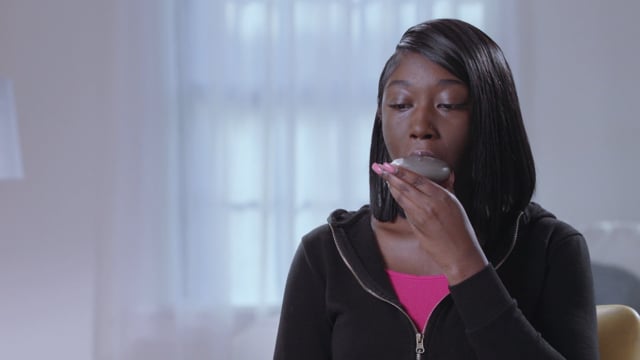- Parents Home
- Para Padres
- A to Z Dictionary
- Allergy Center
- Asthma
- Cancer
- Diabetes
- Diseases & Conditions
- Doctors & Hospitals
- Emotions & Behavior
- First Aid & Safety
- Flu (Influenza)
- Food Allergies
- General Health
- Growth & Development
- Heart Health & Conditions
- Homework Help Center
- Infections
- Newborn Care
- Nutrition & Fitness
- Play & Learn
- Pregnancy Center
- Preventing Premature Birth
- Q&A
- School & Family Life
- Sports Medicine
- Teens Home
- Para Adolescentes
- Asthma
- Be Your Best Self
- Body & Skin Care
- Cancer
- Diabetes
- Diseases & Conditions
- Drugs & Alcohol
- Flu (Influenza)
- Homework Help
- Infections
- Managing Your Weight
- Medical Care 101
- Mental Health
- Nutrition & Fitness
- Q&A
- Safety & First Aid
- School, Jobs, & Friends
- Sexual Health
- Sports Medicine
- Stress & Coping
What Are Nebulizers and Inhalers?
What Are Nebulizers and Inhalers?
Nebulizers and inhalers are tools that help kids take medicines that are breathed in for conditions like asthma or cystic fibrosis (SIS-tik fye-BROH-sis). To work as they should, the medicines need to get into the lungs.
These breathing treatment tools are effective when used properly. But each has their pros and cons — so talk to your doctor about which one is best for your child.

Using a Nebulizer
Learn step-by-step how to use a nebulizer for asthma.

Using a Dry Powder inhaler
Learn step-by-step how to use a dry powder inhaler for asthma.

Using an Inhaler With a Spacer
Learn step-by-step how to use an inhaler with a spacer for asthma.
Nebulizers
Nebulizers are electric- or battery-powered machines that turn liquid medicine into a fine mist so that kids can breathe it in. A nebulizer usually has four parts:
- Cup
- Motor
- Tubing
- Mouthpiece or face mask (a kind of plastic cup that covers the mouth and nose)
How Nebulizers Work
Medicine is put into the nebuizer's cup, which is attached to the motor using tubing. The mouthpiece or face mask is then attached to the cup. When the machine is turned on, it makes a mist that your child can breathe in.
Kids don't have to "do" anything to receive the nebulizer medicine except stay still and breathe in. It usually takes about 5 or 10 minutes to breathe in all the medicine. A child who doesn't stay still and cooperate, or who cries, may not get all the medicine needed. When kids use a nebulizer, it's important to help them not move and be as calm as possible.
Nebulizers can be big and noisy and aren't always easy to carry around.
Inhalers
Inhalers are little devices that can fit in your hand and are small enough to carry in a backpack, purse, or pocket. Some kinds deliver the medicine in a puff and are called metered dose inhalers (MDIs) or puffers. Other inhalers have the medicine as a fine powder that kids pull into their lungs with a quick, deep breath. These are called dry powder inhalers.
Metered Dose Inhalers
MDIs look like mini aerosol cans and push out a pre-measured spray of asthma medicine. When a person squeezes the inhaler, a measured "puff" of medicine is released.
Some MDIs have counters that show how many doses remain. If there's no counter, the number of doses already used should be tracked so that the inhaler can be replaced on time.
MDIs require coordination when used on their own. A child must be able to activate the device and breathe in at the same time. If not, the medicine can get stuck in the back of the throat instead of reaching the lungs. That's why many doctors recommend attaching the metered dose inhaler to a spacer.
Spacers
A spacer is a kind of holding chamber for MDI medicine. It attaches to the inhaler on one end and to a mouthpiece or face mask on the other end. When someone pushes down on the inhaler, the medicine stays in the spacer until the person is ready to breathe it in. So, very young kids and even babies can take their medicines using an MDI with a spacer because they don't have to "do" anything other than sit and breathe.
With a spacer, it usually takes less than 30 seconds to get medicine into the lungs.
Dry Powder Inhalers
Dry powder inhalers often look like a disc or tube and they deliver medicine as a powder. The powder is breathed in, but it doesn't spray out. Kids need to do more of the work by inhaling the powdered medicine quickly and deeply. Many children can do this when they're around 5 or 6 years old.
Doctors tend to prescribe dry powder inhalers less often than MDIs.
What Else Should I Know?
Using nebulizers or inhalers can be tricky until you get used to them. So, ask your doctor to show you how the device works before you (or your child) first try it. Doctors might have an older kid or teen demonstrate using the inhaler so they can offer advice, if needed. With practice, kids can get very good at using inhalers.
If you have any questions or if you're concerned that your child isn't getting the right dose of medicine, talk to your doctor.